|
Diamond Fever
|
With the discovery
of diamonds in Nunavut, Canada, in the early 1990's, a new area was heralded into mineral
exploration and mining history. The result of the staking rush and diamond discoveries has
been a widespread interest in diamonds by the prospecting and geological community which
has led to active exploration for the elusive gem throughout Canada, and specifically, the
Canadian Shield. |
Round Brilliant Diamond
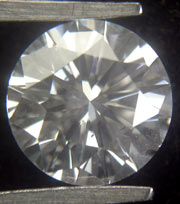
Cut diamond (enlarged) |
|
Like many, I was generally unfamiliar with the
origin and emplacement of diamonds, other than that it had something to do with a rock
called Kimberlite, a lot of diamonds were being mined in South Africa, and they tended to
be found within continental cratons or shield areas.
- After some investigation of available information, I came
across a Gem and Gemnology publication titled: "Age, Origin and Emplacement of
Diamonds" (Kirkley, et. al.). This is an excellent summary on much of what is
understood about the geological origin of diamonds, and I have referred to it liberally
throughout this article.
|
|
What is a Diamond?
Natural diamond crystals
|
A diamond is a crystal which is
composed of the element, carbon. In nature, diamond crystals display a crystal habit, but
often the crystal shape has been rounded or abraided during emplacement. Diamonds
typically occur in a rock called Kimberlite and in related cousins (Lamproite). |

|
|
What is a Kimberlite?
Kimberlite is a 'hybrid' rock composed
of fragments of peridotite and eclogite derived from beneath the deep crust in the upper
mantle of the earth, as well as fragments of various rock types derived from higher levels
in the crust. These fragments are contained in a finer matrix composed of the crushed and
disaggregated fragments and crystallized minerals from a potassic-ultramafic (kimberlite)
magma. The matrix also contains minerals which reflect lower temperatures and a high
volatile content (H20 and CO2), such as calcite, phlogopite, and serpentinite. |
|
Chemically, Kimberlite
is an ultramafic rock with high potassium, water, and carbon dioxide. The high potassium
may display itself as phlogopite mica, carbon dioxide as calcite, and water as hydrated
minerals like serpentine. Commonly, kimberlite found at surface is highly weathered,
rubbly and yellow-brown in colour. With increasing depth it becomes harder and grey in
colour (Cannon and Mudrey, 1981). |
Kimberlite
sample with embeded diamond crystal
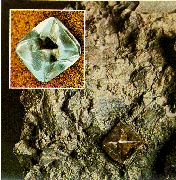 |
|
Origin of Diamond
Although diamond crystals are found in Kimberlite and related
rocks, the origin of diamond is more closely related to the fragments of peridotite and
eclogite which are derived from the upper mantle, below cratonic (shield) areas. In order
for diamonds to form, they require extremely high pressures and temperatures which are
only found in these deep levels of the earth. It is here that the rock, eclogite, forms
consisting of red pyrope garnet and green clinopyroxene; diamond crystals develop
alongside the garnet and pyroxene crystals.
- Peridotite fragments (xenoliths) composed of garnet, olivine, and orthopyroxene
also contain diamonds and are similarly derived from the upper mantle. However, these
fragments commonly disaggregate during the emplacement process resulting in a matrix
containing the disaggregated minerals of olivine, pyroxene, and diamond (xenocrysts).
Types of Diamond Crystals
Because diamonds have a close affinity to the type of fragment
(eclogite, peridotite) and their respective source areas, they can be subdivided into
those which have a peridotitic origin (P-type) and those which have an eclogitic origin
(E-type). Even though a diamond may be found as a xenocryst (single crystal) within the
Kimberlite matrix, inclusions or flaws within the diamond crystal can identify its
origins. These flaws or inclusions within diamonds can consist of associated minerals such
as garnet, pyroxene, olivine, chromite, and sulphides (pyrrhotite). The chemistry of the
mineral inclusion can be compared with that of those present in the eclogite and
peridotite fragments to determine their source. These inclusions also provide valuable
information which allows for the determination of pressure and temperature of formation as
well as age.
Chemistry of Diamond inclusions
|
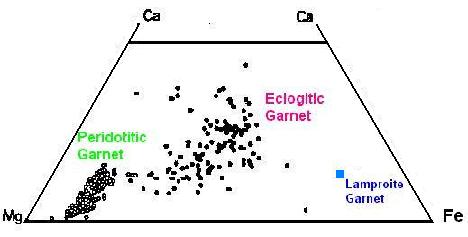
After Kirkley, M. B. et. al. (1991) |
Age of Diamonds
By analysing the diamond inclusions such as pyroxene and garnet,
which contain measureable quantities of radioactive elements (U/Pb), it is possible to
establish a radiometric age for the inclusion and by extension for the the diamond
containing it. Similarly radiometric age dates can be established for the minerals which
crystallized during the emplacement of the Kimberlite host rock. Comparing the age of the
diamond with that of the host rock, we see that the diamond crystals are older than the
time at which they were emplaced. In many cases diamond crystals have been resident in the
upper mantle for billions of years prior to their more recent emplacement (~100 my age).
This geochronological evidence supports the view that diamonds are formed in the upper
mantle of the earth and do not crystallize as part of a Kimberlite 'magma' as once had
been believed.
Age of diamonds and age of emplacement
|
| Location (Mine) |
Age of Diamond |
Age of Kimberlite |
Type of Inclusion |
| Kimberley, South Africa |
~3,300 |
~100 |
Peridotitic |
| Finsch, South Africa |
~3,300 |
~100 |
Peridotitic |
| Finsch, South Africa |
1,580 |
~100 |
Eclogitic |
| Premier, South Africa |
1,150 |
1,100-1,200 |
Eclogitic |
| Argyle, Australia |
1,580 |
1,100-1,200 |
Eclogitic |
| Orapa, Botswana |
990 |
~100 |
Eclogitic |
| After Kirkley, M. B. et. al. (1991) |
Carbon Sources
The classification of diamond crystals based on peridotitic (P-type) and
eclogitic (E-type) host source rocks is also reflected in the carbon isotopic composition
of the diamond. Carbon has isotopic characteristics that can guide us in determining the
source of the carbon and as such provide some insight into how the diamond and its source
rock formed.
Carbon Isotopic Composition of Diamonds
|
| Carbon isotopic studies, generally speaking, measure
the Carbon 13 to Carbon 12 ratio (expressed as delta 13 C). These Carbon isotopic ratios
indicate that diamonds of a peridotitic origin have a smaller range (-10 to 0) than
diamonds of an eclogitic origin (+3 to -34). Modified from Kirkley, M. B. et. al.
(1991) |
 |
The explanation for this difference is based on the differing origins for these
rocks and their contained carbon. The eclogite is thought to form as the residue from
partial melting of a subducting oceanic slab which contains rocks with a wider range of
carbon isotopic values. This carbon may be derived from carbonates and hydrocarbons near
surface. On the other hand, the peridotitic diamonds have carbon isotopes that have not
been significantly fractionated (smaller range) and are probably derived from a more
homogeneous source representing original constituents of the primitive earth's mantle.
Plate Tectonics
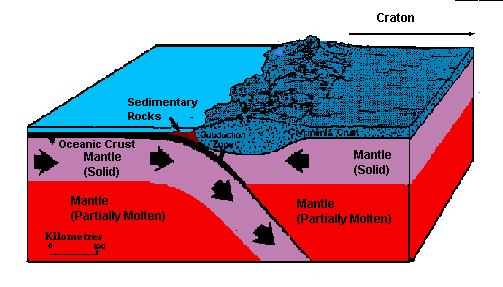
Formation of eclogite as a residue from partial melting of subducting oceanic slab;
(modified from Kirkley, M. B. et. al. 1991) |
Emplacement
| Diamond-bearing Kimberlites and related rocks represent
constituents of the upper mantle which have been emplaced into shallow levels of the
earth's crust. A basic requirement for their emplacement is the presence of fractures
which extend below the base of the craton. Once a fracture taps these deep levels, the
combination of high pressure, temperature and high content of volatile constituents (H2O
and CO2) result in the release of a Kimberlite 'magmatic fluid' from depths of at least
100 kilometres. The initial ascent is rapid, with speeds estimated in the order to 10-30
kph. Within 2 - 3 km of surface, the velocity of the magmatic fluid increases to several
hundred kph ( Kirkley, M. B. et. al. , 1991). This rapid increase is due to
a combination of low pressure and interaction with high-level ground water, resulting in
explosive brecciation of wallrocks and the formation of a kimberlite 'pipe'. |
Kimberlite Pipes
The explosive emplacement of the volatile-rich kimberlite magmatic fluid results
in the development of near surface kimberlite 'pipe'. These pipes have a 'carrot' shape
ranging in diameter from several hundred metres near surface, narrowing to 1 -10 metres at
depth. The carrot-shape pipes generally extend over a vertical distance of 2 - 3
kilometres.
Idealized Model of a Kimberlite Pipe
|
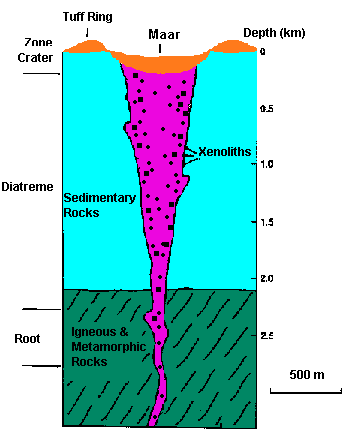
Modified from Kirkley, M. B. et. al. (1991)
|
- An idealized model of a kimberlite pipe can be subdivided into three zones: the
root, diatreme, and crater. The root zone is characterized by crystallized kimberlite
magma with typical intrusive textures and containing xenoliths (fragments) and xenocrysts
(crystals). The root zone extends into a feeder dike or fractures along which the magmatic
fluid passed through.
The diatreme zone is the main source of diamonds due to its larger size and
volume of kimberlite rock. It contains the bulk of the xenoliths derived from the mantle
as well as framents of wall rock. This is the zone where rapid expansion of the kimberlite
magmatic fluid occurs with its attendant explosive behaviour due to the contained
volatiles. With expansion, rapid cooling also takes place such that there are few thermal
contact metamorphic effects and diamond crystals are able resist conversion to graphite. |
|
| When a kimberlite pipe is emplaced, the surface expression is that
of a small explosive volcanic eruption consisting of fragments and hot gases
(pyroclastic). This volcanic explosion results in the formation of a small volcanic
edifice consisting of a crater (Maar) and a pyroclastic (tuff) ring. Kimberlite volcanoes
have not been documented mostly because they tend to be small in size and are easily
eroded. |

Shape of the A154South Diavik Kimberlite Pipe,
Reference: Aber Diamond Corporation.
|
|
Putting it all together
Although diamond crystals form in the upper mantle below cratonic areas, they
can only remain stable at these high pressures and temperatures. The mantle xenoliths and
diamond crystals that are brought quickly to surface in a Kimberlite magmatic fluid are
able to survive near surface in a 'quenched' or 'meta-stable' state. If the intrusion of
kimberlite is delayed during its rise to surface or is trapped in the lower crust, diamond
crystals will not be stable in the P-T environment and will revert to graphite.
| It is under shield areas or cratons that the diamond crystals can remain stable
at shallower depths due to the low geothermal gradient related to the sub-cratonic keel
beneath continental crust. This P-T environment has been referred to as the diamond
'storage area' (Kirkley, M. B. et. al., 1991). The keel area is an optimal
source for diamonds since fractures below the craton are more likely to tap this area and
remain accessible to the surface. |
|
Diamond-Graphite Stability & Geothermal
Gradients
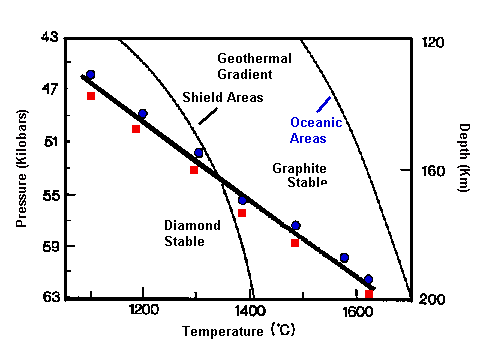
Modified from Kirkley, M. B. et. al. (1991)
|
|
Peridotitic diamonds are most likely to be tapped from this
storage area, but if the fractures extend further, they may also include eclogitic
diamonds (K1). Eclogitic diamonds form at greater depth than peridotitic diamonds and
represent the residue from the partial melting of subducted oceanic slabs that underplate
the cratonic/upper mantle 'keel' (K2). These areas also give rise to Lamproite (Kimberlite
cousin) intrusions closer to the edges of the craton (L1)
Idealized model of sources of diamonds beneath the craton
|

Modified from Kirkley, M. B. et. al. (1991) |
Under oceanic crust, temperatures increase more rapidly than under shield areas
(high geothermal gradient). The equilibrium line between diamond and graphite intersects
the oceanic geothermal gradient at depths of greater than 200 kilometres. This depth is
considered to be unsuitable for the production of diamonds, likely due to the inability of
fractures to propagate to that depth in an oceanic envirnment (too hot). However, recent
discoveries of diamond-bearing 'Lamproite-like' rocks have been identified in Archean
volcanic terrane (Michipecoten Greenstone Belt). It remains to be seen whether these micro
and macro-diamonds in Archean-age rocks will carry diamonds of a sufficient size and
quantity to be economic.
- Diamond crystals may in fact be fairly common below cratonic and oceanic areas at
the required P-T conditions for their formation. Those below cratons have produced
economic diamond mines, likely due to their long residence time which perhaps gives the
diamond the opportunity to grow to gem quality.
Exploration for Diamonds in Ontario
Much of the shield area of Ontario is highly fractured, with large fractures and
faults providing access ways for deep-level igneous rocks as exemplified by the presence
of carbonatite and accompanying alkalic intrusions. Most kimberlite pipes discovered to
date are about 150 my old and follow older structures that have had repeated movement over
time (Kapuskasing Structural Zone); a few pipes are mid-Proterozoic in age. Notable, the
kimberlite pipe discoveries tend to have been found within Paleozoic cover rocks overlying
the craton. This may simply reflect the use of geophysical techniques for exploration and
the high magnetic contrast between the sedimentary rocks and the kimberlite pipes. There
is also the view that the change from igneous and metamorphic crust into the overlying
sedimentary cover rocks may also influence pipe development.
Kimberlite Indicator Minerals (KIM) in the Batchewana
Area, Ontario
|
| Analysis of surficial deposits of recent river gravels and sands
indicate that kimberlite indicator minerals (KIM) are present over wide areas of Ontario.
These indicator minerals are the mineralogical and chemical signature that identify a
kimberlite source rock. The major problem for the prospector and explorationist is that
these samples represent transported (glacial) overburden, such that the original KIM
source is very difficult to trace. Note: pie size proportional to KIM #, Colour = KIM type |
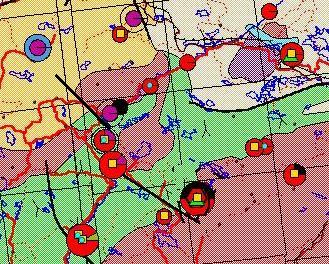
|
Lithology Legend:
Green = Greenstone Belt
Yellow = Gneisses
Purple = Granites
Grey = Metasediments
Black& Blue = Mafic Intrusions |
Prospectors and explorationists require knowledge of the glacial geology,
transport distance of various glacial materials, and the drainage basins from which the
samples were taken. It is not simply a matter of staking a claim around a KIM anomaly.
One place to start is by prospecting around these KIM anomalies, in the country
rocks for any signs of brecciation, breccia zones, and the presence of exotic fragments
(eclogite and peridotite). Geological prospecting can be supplemented by detailed magnetic
surveys since many kimberlite pipes will have a stronger magnetic signature than the
surrounding rocks and will have a small, generally circular shape.
Not all Kimberlites are equal
- Finally, not all kimberlite pipes have diamonds of economic value. Discovery of a
kimberlite pipe does not in itself make a mine, but it certainly raises the diamond
potential of an area. The presence of micro diamonds or even macro diamonds serve as
another significant indicator of the diamond potential of a diamond prospect. From results
of diamond exploration in Nunavut, the real economic value comes from the presence of
larger stones with a higher weight per ton of rock.
Major World Diamond Deposits
|
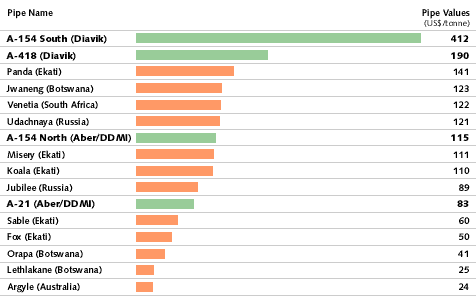 |
Reference: Aber Diamond Corporation web site
(www.aber.ca); Green represents Aber deposits |
|
Diavik A154South pipe diamond reserves,
Nunavut, Canada
|
|
Tonnes
(millions) |
Grade
(carats/ tonne) |
Carats
(millions) |
| Measured |
8.2 |
5.6 |
45.3 |
| Indicated |
3.2 |
5.1 |
16.7 |
| Inferred |
0.6 |
3.2 |
1.9 |
| Total |
12.0 |
5.3 |
63.9 |
| Reference: Aber Corporation web site
(www.aber.ca) |
|
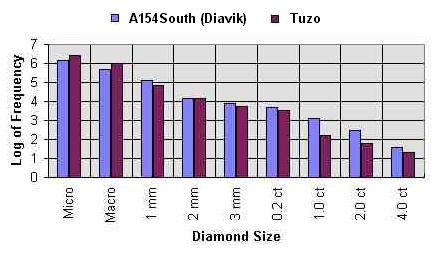
Reference: Aber Diamond Corporation web site (www.aber.ca) |
| Note the large quantities of micro and macro diamonds in these
economic diamond deposits (exponential scale). |
|
|
General Diamond Info |
| Melee |
< 0.15 carot |
| 1 Carot |
0.007 ounces (1 regular
paper clip) |
| 1 Ounce |
142 carots |
| 1 Gram |
5 carots |
| 1 carot |
100 points |
| 1.32 carots |
1 carot and 32 points |
| Best Colour |
colourless |
| Best Clarity |
no internal flaws or
inclusions |
| Best Cut |
Internal reflection through
crown |
| Best Carot |
larger diamonds are rarer |
| 6 mm round diamond |
approximately 1 carot |
| 5x5x3 mm cut diamond |
approximately 0.75 carot |
| Largest Known Diamond |
Cullinan Diamond: 3,106
carots |
References:
Cannon, W.F. and Mudrey, M.G.Jr. 1981: The Potential for Diamond-bearing
Kimberlite in Northern Michigan and Wisconsin, Geological Survey Circular 842, U.S.
Department of the Interior.
Kirkley, M. B., Gurney, J.J., Levinson, A.A., 1991: Age, Origin, and emplacement of
Diamonds: Scientific Advances in the last Decade; Gems and Gemology, Vol. 27, No. 1,
pp2-25, Gemological Institute of America.
-
|













